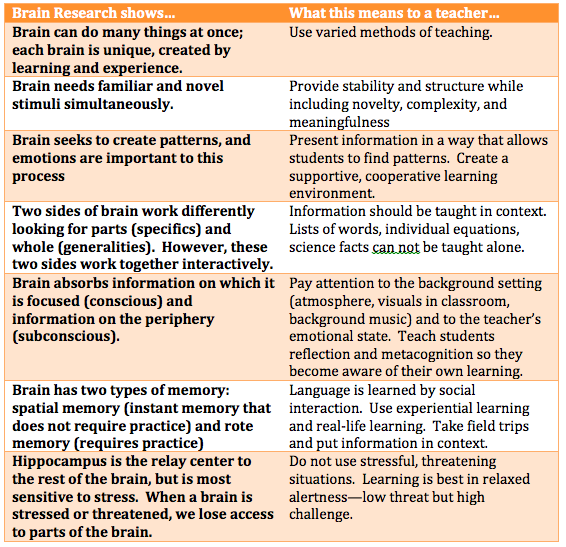Caine, R. & Caine, G. (1990). Understanding a Brain-Based Approach to Learning and Teaching. Educational Leadership, pages 66-70.
This article contains twelve principles from brain-based research and the implications for teaching. These points are synthesized and summarized in the chart.
The goal of Caine and Caine was to introduce brain research and give practical implications for teaching. This piece was written in 1990, and is based on sources from the mid-1980’s. Obviously, this research is outdated for a scholar in 2014; however, I chose it as a historical starting point for my scholarly study of brain research and neuroscience. It is based more on psychology than neurology, and I think it will be interesting to trace the development of this still-fledgling field of study to the present day.
Caine and Caine have written a well-organized article that is clearly divided by headings which help the reader preview and focus on each of the twelve principles. It is a good article for someone who wants to get an overview of the implications of the then-current research about brain functioning and teaching/learning. The suggestions for classroom teachers are clear for anyone to read, without having to understand a lot of formal, technical jargon. This piece helps create the bridge from researchers to practioners. One weakness of the piece is that it does not explain to a reasonable extent the true workings of the brain or the underpinnings of the principles. For example, the first principle is that the brain handles many different tasks simultaneously. But, it does not explain how scientists know this. It is clear that the authors assume that the reader will trust their compilation of previous knowledge and studies, not giving a picture of what those studies actually are.
Implication for humanizing, equitable education.
This article emphasizes that each person’s brain is unique, shaped by the experiences that he/she has had. Also, emotions play a large role in learning, as do the conscious and subconscious. The implication is that teachers need to use a variety of methods in their work. This is consistent with the ideas of a humanizing, equitable education, helping each person have access to learning that will have an impact on their lives.
Also, Caine and Caine suggest that students learn about their own metacognition and reflect upon their educational experiences. This will make them better learners. Any time a person can be given control over their own learning processes, this is an empowering moment. This empowerment can end marginalization by others and humanize the education of each one.
Thoughts for my area of interest.
My take-away from this article was two-fold. First, I thought it contained some sound ideas and concepts for teaching that I would like to try and share with my colleagues. The part of the article that I felt was the strongest argument was the section about the hippocampus and its role in reaction to threatening environments. Its strength came from the clear, yet simple, explanation of the hippocampus as the relay center for the brain. When this center is stressed or threatened, it goes into a different mode and communicates only with the primary areas of the brain. This means that some areas are actually closed-off to us when we may need them. As educators, we need to recognize the stresses that our students have: pressures from family, teachers, schools, and peers; internal pressures to do well on assignments and tests; pressure from high-stakes testing that occurs too frequently. These stresses can trigger a very real physical reaction that students can not control, but which impedes their learning. Teachers should challenge students in a supportive environment, helping them to feel successful and independent in their learning.
Second, at this point, I am just beginning to look into brain research and its implications for teaching and learning. Critiquing this article helps me see my path a little more clearly: I am going to focus more on actual brain functions and how those affect our behavior and learning, rather than a more psychological view.
